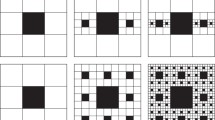Abstract
A new fractal feature, the Directional Fractal Curve (DFC), defined over an arc of 180° and composed of 90 fractal dimensions determined at intervals of arc of 2°, is developed to account for the anisotropic property of a fractal texture. The DFC algorithm is first applied to two images with different textural patterns one without directional preference and one with a well-organised texture. The DFC of these images shows different patterns. The technique is then applied to quantify the structure of the elastic texture in the arterial wall where the elastic network was imaged by scanning electron microscopy following selective tissue digestion. The results suggest: (i) that images of the elastin matrix of the arterial wall exhibit fractal properties with directional preference, (ii) the DFC gives quantitative parameters which allow characterisation of structural changes in the elastin matrix of the arterial wall in terms of disorganisation and fragmentation of elastin fibres—conditions which are associated with medial degeneration due to normal ageing or presence of arterial disease.
Similar content being viewed by others
References
Bartlett, M. L. (1991): ‘Comparison of methods for measuring fractal dimesions’.Australas. Phys. Eng. Sci. Med.,14 (3), pp. 146–152
Caldwell, C. B., Stapleton, S. J., Holdsworth, D. W., Jong, R. A., Weiser, W. J., Cooke, G., andYaffe, M. J. (1990): ‘Characterization of mammographic parenchymal pattern by fractal dimension’,Phys. Med. Biol.,35 (20), pp. 235–247
Chen, Chi-Chang, Doponte, S. J., andFox, M. D. (1989): ‘Fractal feature analysis and classification”,IEEE Trans. Med. Imaging,8 (2), pp. 133–142
Dennis, T. J., andDesspiris, N. G. (1989): ‘Fractal modelling in image texture analysis’,IEEE Proc. F,136, (5), pp. 227–235
Hosoda, Y., Kawano, K., Yamasawa, F., Ishii, T., Shibata, T., andInayama, S. (1984): ‘Age-dependent changes of collagen and elastin content in human aorta and pulmonary artery’,J. Vasc. Diseases,35, pp. 615–621
Jaing, C. F., Avolio, A. P., andCeller, B. G. (1995): ‘Quantification of the elastin lamellar structure in histological sections of the arterial wall by image analysis’,J. Comput.-Assist. Microsc.,7 (1), pp. 47–55
Jiang, C. F., andAvolio, A. P. (1992): ‘Study of age-related changes in the elastic matrix of the human aorta using selective tissue digestion and scanning electron microscopy’,Proc. 1992 Int. Symp. Biomedical Engineering in the 21st Century, Tapei, pp. 349–352
John, R., andThomas, J. (1972): ‘Chemical compositions of elastins isolated from aortas and pulmonary tissues of humans of different ages’,Biochem. J.,127, pp. 261–269
Keller, J. M., Chen, S., andCrownover, R. M. (1989): ‘Texture description and segmentation through fractal geometry’,Comput. Vision, Graphics, Image Process,45, pp. 150–166
Levenberg, K. (1944): ‘A method for the solution of certain problems in least-squares’,Quart. Appl. Math.,2, pp. 164–168
Lundahl, T., Ohley, W. J., Kay, S. M., andSiffert, R. (1986): ‘Frarctional Brownian motion: a maximum likelihood estimator and its application to image texture’,IEEE Trans. Med. Imaging,MI-5 (3), pp. 152–161
Mandelbrot, B. B. (1982): ‘The fractal geometry of nature’ (W. H. Freeman and Co., New York)
Marguardt, D. (1963): ‘An algorithm for least-squareds estimation of nonlinear parameters’,SIAM J. Appl. Math.,11, pp. 431–441
Milch, R. A. (1965): ‘Matrix properties of the aging arterial wall’,Monographs in Surgical Sciences,2 (4), pp. 261–351
Nakashima, Y., Shiokawa, Y., andSueishi, K. (1990): ‘Alterations of elastic architecture in human aortic dissection aneurysm’,Laboratory Investigation,62 (6), pp. 751–760
Nakashima, Y., andSueishi, K. (1992): ‘Alteration of elastic architecture in the rat aorta implies the pathogenesis of aortic dissecting aneurysm’,Am. J. Path.,140 (4), pp. 959–969
Nejjar, I., Pieraggi, M. T., Thiers, J. C., andBouissou, H. (1990): ‘Age-related changes in the elastic tissue of the human thoracic aorta’,Atherosclerosis,80, pp. 199–208
Partridge, S. M. (1979): ‘Chemistry and structure of the walls of the large arteries’in Stehbens, W. E. (Eds.): ‘Hemodynamics and the blood vessel wall’ (Charles C. Thomas, London)
Peleg, S., Naor, J., Hartley, R., andAvnir, D. (1984): ‘Multiple resolution texture analysis and classification’,IEEE Trans. PAMI,6 (4), pp. 518–523
Pentland, A. P. (1984): ‘Fractal-based description of natural scenes’,IEEE Trans. PAMI,6 (6), pp. 661–674
Pentland, A. P. (1986): ‘Shading into texture’,Artif. Intell.,29, pp. 147–170
Shigemi, U. (1972): ‘Histological and histochemical studies on the aging process and atherosclerosis of the human aorta’,J. Fukuoka Med. Assoc. 63 (11), pp. 432–450
Spina, M., Garbisa, S., Hinnie, J., Hunter, J. C., andSerafini-Fracassini, A. (1983): ‘Age-related changes in composition and mechanical properties of the tunica media of the upper thoracic human aorta’,Arteriosclerosis,3 (1), pp. 64–76
Taylor, R. I., andLewis, P. H. (1994): ‘2D shape signature based on fractal measurements’,IEEE-Proc.-Vis. Image Signal Process.,141 (6), pp. 422–430
Toda, T., Tsuda, N., Nishimori, I., Leszczynski, D. E., andKummerow, A. (1980): ‘Morphometrical analysis of the aging process in human arteries and aorta’,Acta Anat.,106, pp. 35–44
Tuttle, R. S. (1966): ‘Age-related changes in the sensitivity of rat aortic strips to norepimephrine and associated chemical and structural alterations’,J. Gerontol.,21, pp. 516
West, B. J. (1990): ‘Physiology in fractal dimensions: error tolerance’,Ann. Biomed. Eng.,18, pp. 135–149
Wolinsky, H., andGlagov, S. (1967): ‘A lamellar unit of aortic medial structure and function in mammals’,Circ. Res.,XX, pp. 99–111
Author information
Authors and Affiliations
Rights and permissions
About this article
Cite this article
Jiang, C.F., Avolio, A.P. Characterisation of structural changes in the arterial elastic matrix by a new fractal feature: directional fractal curve. Med. Biol. Eng. Comput. 35, 246–252 (1997). https://doi.org/10.1007/BF02530045
Received:
Accepted:
Issue Date:
DOI: https://doi.org/10.1007/BF02530045




